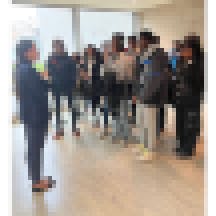WASHINGTON, D.C. — On a Friday morning in March, students and teachers gathered at a hip hotel here to reimagine what their high schools could be.
The delegation from Calvin Coolidge High School was thinking big — as in, global. For months, they’d been crafting plans to reframe their school’s curriculum around the United Nations sustainable development goals, 17 lofty targets that world leaders named as priorities in 2015 that include zero hunger, gender equality, and clean water and sanitation for everyone on Earth.
To explain this idea to the more than 100 people gathered in the hotel ballroom, students from Coolidge tossed around a colorful soccer ball. Each panel stitched to the ball represented one of the U.N. goals, which students referred to, casually, as “SDGs.” Each time someone caught the ball, he or she read aloud the SDG that landed face up, then reflected for a moment about what that global goal might mean locally, or personally.
A failing city is not a city, said one student.
No justice, no peace, added another.
If there is no community, there is no city, said a third.
This activity was part of a design workshop hosted by DC + XQ, a partnership between the city’s public schools and the nonprofit XQ Institute. Funded by Emerson Collective, a corporation that donates and invests money in social change efforts, XQ Institute currently supports programs intended to “rethink high school” at 30 schools and school districts nationwide. The organization describes its ultimate goal as graduating more students who have fundamental knowledge and skills, collaborate well, think creatively and are motivated to keep learning throughout their lives.
XQ Institute hosts contests that award money and other resources to proposals for changing high schools, or for creating new ones. The organization helps teenagers, teachers and school leaders hone the visions they pitch over many months by guiding them through information-gathering activities like hosting focus-group conversations with parents and taking field trips to check out thriving schools in other cities.
The first two high schools to win the DC + XQ competition, in 2022, had embraced the themes of Afrofuturism and entrepreneurship. At this event in the hotel, representatives from other high schools in the city fine-tuned their own proposals, hoping to be selected into the second cohort of winners.
Although the verb keeps changing, D.C. is no stranger to attempts to “reform” or “rethink” its schools. Past efforts have yielded mixed results. And school district leaders here say they have encountered some skepticism about the DC + XQ campaign.
Yet as schools try to shake off the side effects of the COVID-19 pandemic, the need for fresh approaches to reach students seems clear. In the nation’s capital and nationwide, academic test scores are down and many students regularly bail on classes.
It’s a moment when XQ Institute’s agenda — that schools should offer more project-based learning, allow more flexibility in their schedules, and assign classwork more explicitly connected to career paths that interest students — may excite education leaders searching for solutions.
Yet measuring whether a redesigned high school is working as intended, and why, is difficult to do. And evidence about whether DC + XQ’s work makes a lasting difference in the lives of D.C. teens won’t arrive for a while.
In the meantime, the checkered history of school reform did not seem top of mind for students from Coolidge. Some said that simply being asked what they think about their high school had already improved their perceptions about education.
“When I first came to this school, I felt as if student voices didn’t matter,” said Shamiyah McGee, a rising junior who is participating in the redesign process. “It went from me feeling like my voice was never heard to me bringing out ideas that are constantly heard.”
Building Partnerships
XQ Institute launched with a bang. In 2015, it created the Super School Project, a contest to distribute millions of dollars to proposals for innovative high schools. In 2016, XQ Institute spent more millions on a public awareness campaign to promote its ideas about reforming education, papering its branding on buses and bus stops. In 2017, it advanced its message through a celebrity-studded network TV special, featuring Tom Hanks and James Corden doing karaoke on a school bus.
Reviews of this approach — both its style and substance — were mixed. So was its success. Some school models that received money from XQ Institute never opened, and other contest-winning schools have since closed.
When wealthy donors and foundations have tried to improve schools by searching for a single innovation or intervention that will boost education — the way a new vaccine can dramatically improve public health — it usually hasn’t worked, said Phil Buchanan, president of the Center for Effective Philanthropy.
“If you look at the sum total of the efforts, I’m not sure you’d give them the highest grades,” he said. “Focusing on education, education reform — whatever you want to call it — achieving better educational outcomes, as a philanthropist, is a good way to become humble rather quickly, because it usually doesn’t go as folks hope.”
Yet he thinks that philanthropy leaders are exercising more humility lately, including about education. He has observed that donors and foundation executives are doing more listening to the people closest to the problems they hope to solve. He thinks philanthropists are realizing “that in fact there might be a lot of expertise and experience in communities, maybe even in families themselves that are affected.”
That’s the approach that D.C. school leaders said they’ve been taking for the past few years as they started their own efforts to rethink the city’s schools. In 2018, D.C. Public Schools created a design lab, which invited principals, teachers and staff to workshop solutions to problems.
Then the district grew the effort into a wholesale redesign process with two high schools in D.C. neighborhoods where average income levels are lower than in the rest of the city and where the vast majority of residents are Black. School leaders talked with thousands of community members there, according to Paige Hoffman, deputy chief for school improvement at D.C. Public Schools.
“Too often, the folks who are closest to the problems or issues that we’re trying to tackle are furthest from decision-making,” Hoffman said. “And we thought we should change that, and we should shake that up.”
In these conversations, D.C. residents reflected on questions like What do you want to see out of school? and Why has school not been working?
In February 2022, XQ Institute and D.C. Public Schools formed its partnership to redesign high schools in the city, which granted the school district up to $25 million. (For comparison, in its 2022 fiscal year, D.C. spent about $2 billion in local taxpayer dollars on public education.)
To Hoffman, the timing felt right. The COVID-19 pandemic had weakened the city’s social immune system, undermining institutions like schools that help to prevent the spread of contagions like crime and unemployment.
When XQ Institute came calling, Hoffman said, “I think it was in many ways exactly what we as a school district really needed.”
After all, she had heard D.C. residents express that “we have not been in community together in years, and we desperately need to rethink high school, especially when we think about all that our students lost over the previous years and also all of the opportunities that are to come for them.”
Leaders at Coolidge felt similarly. When DC + XQ collected and shared information with them about how their students had fared during the health crisis, “the data was really compelling to us,” said Kira Rowe, a school counselor at Coolidge. “It was definitely eye-opening.”
Students at Coolidge said they wanted more hands-on learning and a deeper understanding about how school prepared them for the real world. They reported being anxious and depressed at higher rates than before the pandemic. And they wanted to change what felt to them like segregation taking root in their school building, creating tension between the two-thirds of students who are Black and the fifth of students who are English language learners, most of whom are Hispanic.

Coolidge administrators and educators decided to develop a proposal for the DC + XQ contest. They sought to blend student well-being, sustainable practices and academic rigor. Then they happened upon the United Nations sustainable development goals, Rowe said, “which we just instantly fell in love with.”
Coolidge students interviewed their classmates to find out whether the theme felt meaningful.
“A question I had to ask them was which one of these SDGs they cared about the most. There was never a time a student said, ‘I don’t care about any of them,’” McGee, the rising junior, recalled. “It showed these SDGs actually can have a heart to heart experience with the students.”
Her personal favorite? “Gender equality — SDG 5,” she said. “I can connect myself to that.”
Because the global goals emphasize universal values, Coolidge leaders thought that they might appeal to students and families who had immigrated to D.C. from elsewhere. One evening, the school invited families from African and Central American countries to share a meal of Ethiopian and Latin American food and to talk about which sustainable development goals resonated most with them. The response was enthusiastic, school leaders said.
All this feedback suggested that the theme had potential to improve the school curriculum.
“Sustainable practices seem to be the only way to at least continue to give back to our planet, make it healthy as well, and make our students healthy,” said Coolidge principal Semanthe Bright. “Why not rethink Coolidge? We can’t go back to doing the same thing we did before the pandemic. Now is the time.”
Engaging Students
William Hayes-Jerome is a rising junior at Coolidge. He described himself as a student-athlete — he plays football for the school team — and as an advocate for his classmates. He’s observed that many of them don’t much like being at school.
Maybe, he said in an interview, eight hours of lessons is just too long.
“Most students don’t have the right attention span to be sitting there in the classes,” Hayes-Jerome said.
He suggested that it might help to change the schedule of the school day, so that it offers more opportunities for students to move around, and, he explained, to “actually communicate with somebody about how the day is going.”
Student disengagement is not a totally new problem. In surveys of 230,000 students in grades three through 12 conducted from 2012 to 2017 by YouthTruth, an education research and consulting nonprofit, only 46 percent of high school respondents felt that what they were learning in class helped them outside of school. And only 52 percent of students across middle and high school agreed or strongly agreed that they enjoyed coming to school most of the time.
Data and anecdotes suggest that the pandemic has only made those trends worse.
Studies from DC + XQ found some of the city’s students reported being bored in class, as well as feeling unsure of why they were studying the assigned curriculum. This dissatisfaction is tied to high levels of truancy in schools, said Keith Dysarz, head of state and local partnerships for XQ Institute. For example, nearly half of D.C. students (48 percent) were absent for 10 percent or more of the 2021-2022 school year, according to a report from the D.C. Policy Center, a research organization.
While there is a lot of focus on grades and test scores coming out of the health crisis, “academic learning loss does not happen in a vacuum,” observed Jen Vorse Wilka, executive director of YouthTruth. To succeed intellectually and emotionally, she explained, students need “strong culture, engaging learning opportunities that feel relevant and connected to students’ lives, relationships, a sense of agency, and an opportunity to express their own opinions about their learning.”
Those qualities align with what XQ Institute leaders said they advocate for in redesigned high schools.
“If students aren’t engaged, they actually aren’t learning,” Dysarz said in an interview. “For us, engagement isn’t just a lesson hook, or, you know, maybe an interesting topic that they care about. It’s also, quite honestly, about making it relevant and real world.”
At the DC + XQ design day in March, students and teachers from Coolidge worked in small groups to rearrange Post-it notes on large posters attached to the ballroom’s walls, brainstorming activities related to the sustainable development goals that they hoped would be both educational and enjoyable to their classmates.
Ideas surfaced about planning field trips to a hospital; asking students to create community service events; making more use of the school garden; and using gallery walks to prompt students to respond to each other’s work.

Then the small groups met up, and students offered each other feedback on their ideas. Teachers and administrators chimed in, too. One student wondered aloud whether certain activities would seem too ordinary to other teenagers. An adult suggested that rather than trying to make a school exercise feel “fun,” they instead aim to make it “engaging” and “interactive.”
An idea floated about using social media as part of a classroom activity. That might be too distracting, someone said. Teachers snapped their fingers in agreement.
An educator reminded the students to consider how to design experiences for all of their peers — not just the kinds of students who earn all A’s (or show up to extracurricular design workshops). They talked about whether a little competition helps to motivate participation in class. They thought about how upperclassmen can help set a good example for younger students. They discussed the value of creating multiple activity options for their peers to choose from.
As the students broke back up into smaller groups, the conversation at one table dove into assignment ideas about the importance of water. Students and educators talked about the public health crisis in Flint, Michigan, where the water supply is tainted with lead. They talked about the problem of plastic pollution in the ocean. Someone pulled up photos she had taken during a trip to Colombia of piles of waste she saw there.
By the lunch break, a seminar-style discussion about SDG 6 — clean water and sanitation — was well underway.

Getting Flexible
Pulling off elaborate student projects requires a certain amount of flexibility in the curriculum and in the school day. And making schools more flexible is a top XQ Institute priority.
The prospect of more freedom appealed to science teacher Nikki Wallace when she joined the faculty of Crosstown High School, an XQ Institute partner and charter school in Memphis, Tennessee, which opened in 2018. The summer before the first school year, she collaborated with other teachers to design interdisciplinary projects relevant to real-world situations.
It was exciting. It was challenging. Wallace recalls the “struggle” of trying to devise a long-term assignment about traveling to Mars with a math teacher who wasn’t convinced that it would provide adequate math instruction.
“It wasn’t easy at all,” Wallace said. “It built up a lot of tension.”
Then she had to sell the idea to her students. The framing she used to introduce that project — what’s wrong here on Earth and why do we need to explore Mars? — didn’t land as well as she had hoped. She said that at first, her students got so stuck pondering earthly problems that their imaginations didn’t lift off into space.
And yet, she believes that project made a lasting impression. As those students progressed through high school, Wallace said, the one assignment they seemed to talk about most was the Mars project from that first year.
For a teacher like Wallace to take a risk and try a new instructional approach, she said, the education ecosystem has to have the right conditions to support her.
“You gotta have the willingness of the leadership team to be flexible,” she said. “If leadership sees the benefits, it allows for creativity to happen.”
In D.C., questions about how much flexibility educators and students really have to redesign their schools come up regularly, according to Hoffman, the district leader. After all, schools are governed by plenty of federal and district policies intended to ensure that they impart a rigorous education. School officials also must contend with budget constraints, the needs and interests of educator employees, and the logistics of keeping track of hundreds of teenagers from day to day.
Hoffman hears D.C. educators say, “You want me to dream big, but what parameters” — school rules and regulations — “are you going to pull down?”
So the district is experimenting with change. It’s running pilot programs that allow students to participate in internships during the school day. Leaders are also working to figure out whether certain career and technical courses can convey academic credit — like an engineering elective fulfilling a science requirement that counts toward a diploma.
“You have to figure out how to get comfortable with trying something, with failing, and then learning from that,” Hoffman said.
Creating Accountability
Will creativity in the classroom and flexibility in how students demonstrate their learning be enough to transform Coolidge?
In education, metamorphosis requires more than mere tinkering. So said Elizabeth Chu, executive director of the Center for Public Research and Leadership, an education research and consulting arm of Columbia University.
She argued that true change requires rewiring entire education governance structures, so that they stop delivering “uniform services” and instead prioritize “uniformly attending to the differences that kids and families present and meeting their unique needs.”
“When you're working with these schools, you have to be aware [that] classrooms are sitting within schools, are sitting within districts, are sitting within states, are sitting, obviously, within the federal structure,” Chu said. “And so it means rethinking the policies and procedures at every level of the system that allow for the flexibility and innovation that you need at the particular school level.”
And so, over time, XQ Institute has turned its attention toward influencing policy and reshaping whole school systems, not just individual schools. In 2018, it published a guide encouraging state leaders to adopt the nonprofit’s reform strategies. In 2022, Rhode Island approved new regulations for the state’s high schools after working closely with XQ Institute. Now, the nonprofit is leading an effort to change the national “seat time” requirements that mandate students spend a certain number of hours in the classroom to earn credits and credentials.
Spokespeople for XQ Institute emphasized the grassroots flavor of each school redesign effort. Yet these processes did not germinate totally organically.
The nonprofit’s guide for policymakers suggests a road map for how to prompt communities to change their schools. Step one: Announce a challenge, and make it “ambitious, inspiring, and different.” Step two: Move people to action, with incentives like money. Step three: Help guide the redesign process so that it focuses on “equity, innovation, and excellence,” perhaps by using the resources developed by XQ Institute.
Whether a reform effort emerged from the playbook of a philanthropy juggernaut might not matter much if it ends up working well for students and schools. But that’s not always easy to assess.
One reason why is that change can take a long time, and results can be uneven. For example, after philanthropists (including Mark Zuckerberg) gave $200 million in 2010 to reform public schools in Newark, New Jersey, student academic achievement actually declined for several years, according to the Center for Education Policy Research at Harvard University. Eventually, math scores recovered and English scores surpassed their original levels, but by then, of course, some of the students who experienced the initial shock to the school system had aged out. And researchers found that much of the improvement could be attributed to students enrolling in different schools, rather than achievement going up at existing schools.
Another is that metrics can tell contradictory stories. For example, the D.C. Policy Center report found that the on-time high school graduation rate in the city has been been rising —from 68 percent in the 2018-2019 school year to 75 percent in the 2021-2022 school year — ostensibly a positive development. Yet the college enrollment rate within six months of graduation has been falling — from 56 percent for the class of 2019 to 51 percent for the class of 2021.
Some of the same organizations that poured money into school reform have since supported studies about what actually works. For example, in June, research firm MDRC published an analysis funded by the Bill and Melinda Gates Foundation about which frequently used school reform strategies are linked to better outcomes. They include:
- Strengthening principal leadership
- Using student data to improve teaching
- Setting high standards for academic rigor
- Enabling students to build personal relationships with educators
- Empowering teachers to set goals and make decisions
- Organizing teachers into teams that provide mutual support
- Providing students extra academic help
- Extending classes to allow for longer instructional time
Measuring these kinds of interventions early and often makes a difference in education reform efforts, according to Chu.
“A lot of these redesign processes, especially ones that are very user-centered, are extremely attentive to the process and very intentional in monitoring how things are going. So it’s not five years down the road that you’d realize things aren’t on the right track,” Chu said. “Let’s assess — kind of every single day, every single month, every single semester — how things are going, so that we are serving kids in classrooms today to the best of our ability.”
XQ Institute does help schools conduct audits at the start of their partnerships to assess what’s been working and not working well. These measure quantitative factors like student transcript data as well as qualitative feedback from students about how prepared they feel for life after high school, whether their academic options align with their personal passions and how supportive they feel their teachers are.
Yet XQ Institute does not see itself as the party accountable for ensuring the success of the changes it sets in motion. After all, as a spokesperson put it, flatly, in writing, “XQ does not operate schools.”
However, the nonprofit did share through a spokesperson that “XQ gathers data directly from our schools to understand student experiences in real-time and is also working with a best-in-class third-party evaluator, MDRC, who is conducting a longitudinal study about XQ schools’ impact on their students.” The firm is about a year away from publishing quantitative data, the spokesperson said.
For now, XQ Institute readily shares statistics indicating successes from the high schools it has worked with across the country. For example, at Crosstown in Memphis, 75 percent of the graduating class of 2022 planned to enroll in four-year colleges, according to XQ Institute, higher than the national rate of 47 percent. And 95 percent of its seniors graduated, compared to 80 percent in the surrounding district and 90 percent in the state of Tennessee.
These data points don’t show that, in its short existence, Crosstown has experienced leadership turnover, as well as a walkout among students advocating for a bigger say in how the school functions.
Of course, even if a reform effort worked wonders, it could still raise questions. Like, who gets to attend a redesigned high school and who gets left out?
“You think back to charter school models that have been around for a long, long time. The idea is that they can be laboratories of innovation, and then those innovations can infiltrate the rest of the public schools in that city — and that transfer doesn’t necessarily happen,” said Vorse Wilka, of YouthTruth. “The intention is laudable. And my question would be to what extent it plays out, and to what extent it is broadly accessible.”
And what are the ethics of testing out new school models on students in real time?
“When we’re talking about redesign, we are talking about experimentation to some extent,” Chu acknowledged. But she countered that “when we don’t make changes, and we kind of try and try and try again the same method, you might argue that that’s a less responsible form of experimentation, because we already have an evidence base that indicates that future performance will likely follow past performance, to some extent.”
And what are the implications of a private organization giving millions of dollars to shape the operations of a city’s public schools?
“I think it’s complicated and nuanced, and that the most effective philanthropic efforts engage with those questions, and engage with the people they seek to help, to make sure that those people see that help as the help that they want,” said Buchanan, of the Center for Effective Philanthropy. “But then, also, we need to hold elected officials accountable for the choices they make, and the decisions they make, and what influence they choose to give to others, and who they listen to, and who they take resources from.”
Hoffman, of D.C. Public Schools, said she has encountered some fear and skepticism that D.C.’s redesigned high schools won’t serve students well. Or that the district isn’t serious about seeing the effort through. Or that the project is too idealistic and unrealistic at a time when plenty of youth in the city are worried about life’s basics, like safety.
“I am very frank that we need to earn your trust and we need to be showing you. Don’t just listen to me sit up here and pitch a great vision for you. Hold us accountable, right?” Hoffman said.
But she hopes city residents won’t simply critique from the sidelines, either.
“We also need community members at the table with us along the way,” Hoffman said. “The work of strong schools is not just the work of the public school system alone. It’s the work of families, it’s the work of community partners, it’s the work of higher ed organizations. It’s really about the community and the city.”
Seeking Transformation
Soon after the DC + XQ design session at the hotel, educators took three dozen students from Coolidge to visit the United Nations headquarters in New York City. They saw the golden general assembly hall. They watched world leaders deliberate during hearings. And, undeterred by a winter storm, some students caught their first glimpse of Times Square and the Empire State Building.
In June, DC + XQ named Coolidge as one of four schools in its second cohort of partners.

This coming school year, the high school will continue to refine its new vision. Coolidge will offer a capstone research class based on the United Nations sustainable development goals, which will support students in working on projects with partners including the Smithsonian Institution, the Humane Society, an urban farm and local universities. Students will have more opportunities to travel internationally. Teachers will have more opportunities to learn how to incorporate place-based learning into their classrooms.
Students list the ways that joining in the redesign process has already changed high school for them. Daisy Garcia-Vasquez, a rising senior, said she now has closer relationships with her teachers, and she feels a new sense of school spirit that doesn’t revolve only around sports teams. Hayes-Jerome said he feels like he’s helping to create real change by speaking out on behalf of his classmates.
McGee said she’s been inspired by “seeing so many students come together” through the redesign process. By listening to her peers at Coolidge and students at other high schools across the city, she’s realized that all of their thoughts pooled together can be distilled into one potent drop.
“We all have the same idea: We want school to be more of a safe and interactive and engaging environment for us,” she said.

That single bead of water may ripple out, into the wider city. McGee wants D.C. to support healthier food options — that’s SDG 3. Hayes-Jerome wants to see less gun violence in the city — that’s SDG 16.
Garcia-Vasquez said she hadn’t paid much attention to the environment before she learned about the SDGs. After taking a pilot version of the new Coolidge capstone class, though, she realized she’s passionate about the natural world.
“Something I would love for D.C. to change is the littering,” she said. “If you see trash every day, it makes you feel like you’re in a nasty environment. It changes your mood. If you live in a clean environment, you will feel better.”
Principal Bright said she looks forward to the day she can track graduates and see what contributions they’re making to the wider world because of what they learned at Coolidge.
“I would like to see how they have taken their capstone experience, their travel, as well as their research on the United Nations sustainability goals, and transform wherever they are in society,” Bright said.
That transformation need not wait for some far-off future. Educators at Coolidge said they are advocating to start D.C.’s first voluntary local review committee, to push the city they call home to work toward achieving the sustainable development goals.
They hope that team will be led by youth.


